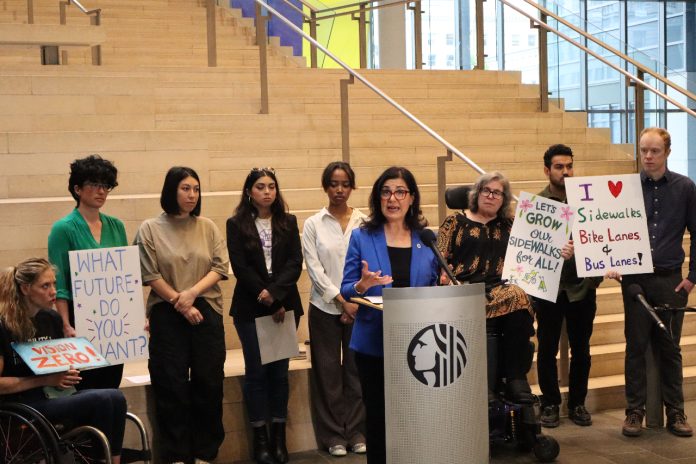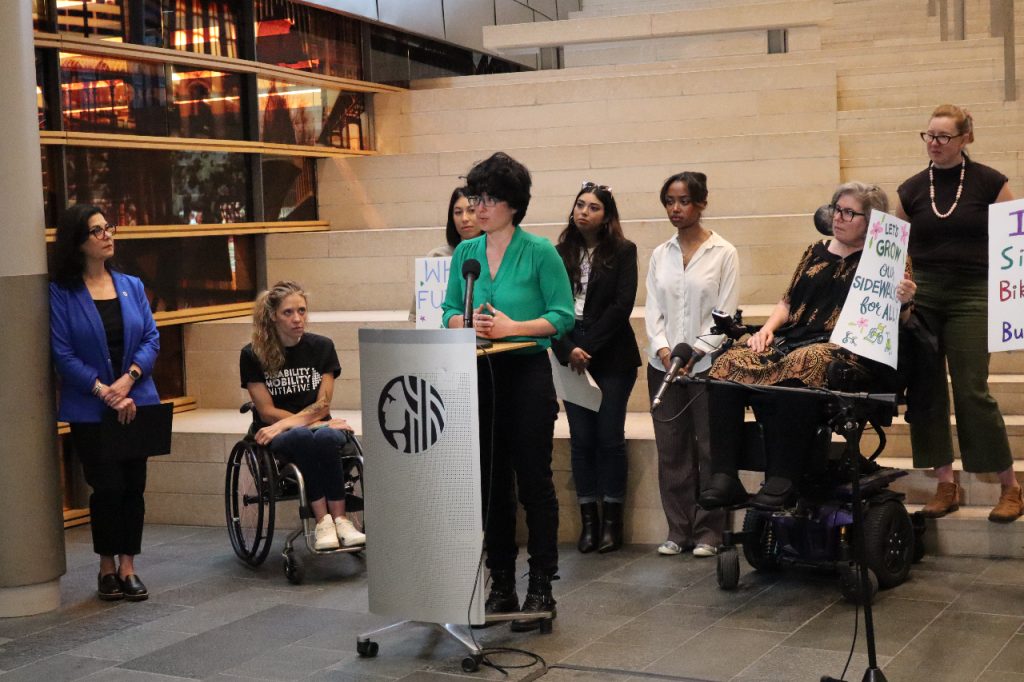
As a final committee vote next Tuesday approaches, Councilmember Tammy Morales has proposed a $150 million increase to the size of Seattle’s next transportation levy to fund additional projects. Morales’ amendment would bring the eight-year levy total to $1.7 billion and add around $18.5 million per year to the budget of the Seattle Department of Transportation (SDOT) through 2032.
Since it was released in early April, the draft levy has seen two $100 million increases, the first by Mayor Bruce Harrell and the second by Councilmember Rob Saka, who chairs the transportation committee chair. However, prior to Morales’ announcement, the city council had seemed content to leave the property tax levy at $1.55 billion. Last week, when a laundry list of proposed amendments were discussed by the council’s select committee on the transportation levy, all amendments — including one from Morales — proposed swapping around funds instead of adding them on.
At that meeting, Morales suggested that she would come back with a new amendment that increased funding, she said, to avoid having to pit different council priorities against one another. But it’s unclear whether Morales will be able to find another four votes to approve this latest increase, even as the amendment drafted by her office makes clear overtures to specific councilmembers to try and get them on board.
Only Councilmember Cathy Moore expressed a potential openness to go bigger last week, while not committing. Almost all of the programs that would see increases under Morales’s amendment had been included in amendments initially offered by other councilmembers, but this would increase the total size of the pie to accomplish more of them.
The proposed $150 million add breaks down as follows:
- $30 million for repaving, with specific funding for projects requested by Councilmembers Saka (35th Ave SW and Fauntleroy Way SW) and Strauss (14th Avenue NW)
- $20 million for protected bike lanes, specifically earmarked to fill in gaps in the bike network on the South End.
- $20 million to connect the Burke Gilman trail via Leary Way NW and NW Market Street, a longtime priority of Dan Strauss.
- $15.5 million for the new Neighborhood Initiated Safety Program, restoring funding that had been cut in Saka’s chair’s amendment.
- $15 million for street trees and street tree maintenance, which no prior amendment had proposed to grow despite significant attention on the issue of Seattle’s tree canopy.
- $14.5 million for new sidewalks.
- $10 million for sidewalk repair.
- $10 million to convert Ballard Avenue’s cafe street into a curbless street, another Strauss priority. Strauss has touted the idea of realigning the popular streateries so that they’re immediately adjacent to restaurants, with pedestrians further out in the street, but has specifically said that the street will remain open to through car traffic.
- $5 million for intersection improvements.
- $5 million for neighborhood greenways. An amendment from Cathy Moore would have eliminated greenway funding from the levy entirely, instead putting that funding into protected bike lanes and upgrades bike lane barriers.
- $5 million for community-based planning around the future Graham Street and Chinatown-International District light rail stations, a priority of community groups like Puget Sound Sage.
At a press conference Thursday morning, Morales was joined by representatives from Seattle Neighborhood Greenways, Disability Rights Washington, and the MLK County Labor Council who have been advocating for a bigger levy, pointing to both independent and internal polling that shows voter support greater transportation investments. In fact, SDOT’s poll specifically asked about a $1.7 billion levy and found 56% support. Before Mayor Harrell even released a draft levy, MLK Labor passed a resolution supporting a $1.7 billion levy, noting “critical and ever-worsening funding gaps for basic maintenance and preservation.”
“I’ve heard loud and clear from constituents across the city, from people in every council district, during our public hearing, and during our public comment period in committee, that voters want a bolder transportation levy. They want a package that prioritizes safety investments for everyone, especially those who are walking or rolling or biking to navigate the city,” Morales said. “This council has the power to do something. Relatively modest investment in our community’s health and safety today will improve our city for decades to come. On the other hand, inaction and underinvestment puts people at risk.”
Seattle Neighborhood Greenways has lobbied for safety investments and reiterated that a larger levy could achieve them without forcing cuts elsewhere.
“Council amendments have been proposed to pit vital programs against each another, and we shouldn’t have to choose between safe routes for kids walking and biking to school and equity-focused safety programs, we shouldn’t have to choose between building and repairing our sidewalks, we shouldn’t have to choose between public open space and protected bike lanes. We need all of those things,” said Clara Cantor, an organizer with Seattle Neighborhood Greenways. “According to the city’s own polling, done by EMC research, the only argument against renewing the levy that cost it significant support, was that it didn’t go far enough and invest enough.”

Within hours, the Seattle Metropolitan Chamber of Commerce came out against Morales’s amendment.
“It is disappointing to see an eleventh-hour attempt to turn a thoughtfully crafted proposal – one that was the result of months of technical work and robust stakeholder engagement – into a proposal that is about quantity, not outcomes that can be delivered,” Rachel Smith, the Chamber’s president and CEO said in a statement. “The Chamber has strongly supported the development of a balanced proposal and we urge the Seattle City Council to approve a levy renewal based on a sound project delivery plan that makes progress in maintenance and mobility, and balances needed investments with affordability concerns.”
Unlike some other amendments, Morales’ proposal responds to the realities of project delivery, scaling back a likely unrealistic goal set by Saka’s proposed chair’s amendment to add 500 blocks of new sidewalks within five years, an unprecedented rate of construction. Instead, the baseline would be reset to 250 blocks within the same amount of time, a number that SDOT said is more doable.
Morales told The Urbanist that she didn’t want to set expectations around new sidewalks too high.
“I am a little concerned about not trying to accomplish so much in an eight-year period, because I don’t know if we have the current staffing, if it requires contracting — what’s the pace of repairs versus the pace of production? — there’s just a lot of variables that I am not an expert on,” she said. “There are a lot of councilmembers who are really focused on that as their win for their district, which I totally understand. And I don’t want to set them up for failure, either.”
Morales said Thursday that she’s meeting with other councilmembers one-on-one about getting them on board with this new proposal but wasn’t joined by any of her colleagues Thursday and didn’t cite any who were specifically on board yet. Morales has often found herself marginalized on the new council, epitomized by the failure of her recent equitable development pilot program after most of her colleagues came up with their own justifications to not support it.
Next Tuesday’s committee meeting will contrast Morales’ competing vision for the next decade of transportation spending in Seattle against the consensus that had already formed, putting the entire council on the record.
Ryan Packer has been writing for The Urbanist since 2015, and currently reports full-time as Contributing Editor. Their beats are transportation, land use, public space, traffic safety, and obscure community meetings. Packer has also reported for other regional outlets including Capitol Hill Seattle, BikePortland, Seattle Met, and PubliCola. They live in the Capitol Hill neighborhood of Seattle.


